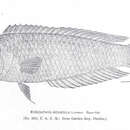en
names in breadcrumbs


Analogues: Larval Xyrichtys have no melanophores and often markedly-narrowed eyes. The absence of external melanophores is shared with larval Doratonotus megalepis, which are distinctly wider-bodied and have large round eyes. All other regional labrid and scarid larvae have melanophores. X. novacula recruits have a lateral stripe broken up into patches or spots and the first two dorsal fin spines are extended while X. martinicensis recruits have an intact stripe and no extended first dorsal fin spines. X. splendens recruits develop a complex pattern of bars and reticulations.
Description: Body thin and long with a markedly narrowed eye (pre-transitional) to large and round (recruits) with a pointed snout and a terminal small mouth. Pectoral fins medium, reach to vent. Pelvic fins stubs. Dorsal and anal-fin bases long, caudal peduncle short. There are no surface or internal melanophores. Transitional recruits show a lateral stripe broken up into patches or spots and the first two dorsal-fin spines are extended.
Diagnosis: The fin-ray count of D-IX,12 A-III,12 and Pect-12 indicates the razorfish genus Xyrichtys. One other regional labrid, Halichoeres cyanocephalus, shares the median-fin ray count, but has 13 pectoral-fin rays and a clearly different body shape. The three Caribbean razorfishes, X. martinicensis, X. novacula, and X. splendens, share fin-ray counts and the larvae overlap in appearance. The species become distinct as they develop juvenile markings: X. novacula recruits are recognized by lateral stripe broken up into patches or spots and the first two dorsal fin spines are extended. The extended dorsal fin spines persist until juveniles reach about 25 mm SL.
The pearly razorfish or cleaver wrasse, Xyrichtys novacula, is a species of wrasse. It is of minor importance to local commercial fisheries and is popular as a game fish. It can also be found in the aquarium trade.[2]
Xyrichtys novacula can reach 38 cm (15 in) in total length, though most do not exceed 20 cm (7.9 in). Its body is elongate and very compressed laterally, the head is flattened, with a steep profile and sharp teeth. Its long dorsal fin extends along most of its back. It has 9 dorsal spines, 12 dorsal soft rays, 3 anal spines and 12 anal soft rays. This wrasse has a yellow-orange or reddish-pink color that is darker on the back and lighter on the belly, sometimes marked with green and gray stripes. Head shows vertical narrow light blue lines and there are scales with brisk reflexes on the abdomen. Upon capture, this fish has been known to turn its mouth and sharp protruding teeth past 90 degrees to either side in relationship to its own body as an attempt to be released from capture.[2]
The pearly razorfish is widespread throughout the western and eastern subtropical and tropical Atlantic Ocean, as well as the Mediterranean Sea. It inhabits clear, shallow littoral areas with sandy or muddy bottoms, at depths of 1 to 20 m. In winter it migrates to greater depths, up to 90–150 m.
Xyrichtys novacula buries itself rapidly in the bottom when disturbed. It feeds on small invertebrates such as crustaceans, mollusks and echinoderms.[2]

A large number of specific names have been determined to refer to this species as junior synonyms:[2]
The Pearly razorfish has been shown to be successful bait for the Greater Amberjack species (aka reef donkey).
The pearly razorfish or cleaver wrasse, Xyrichtys novacula, is a species of wrasse. It is of minor importance to local commercial fisheries and is popular as a game fish. It can also be found in the aquarium trade.